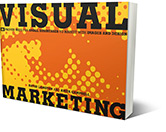We are often told to be more positive. Use the carrot instead of the stick. Sugar works better than vinegar. But does sugar-coating a bad design solution really make it any better?
3 Things Clients Don’t Want to Hear.
We are often told to be more positive. Use the carrot instead of the stick. Sugar works better than vinegar. But does sugar-coating a bad design solution really make it any better?

1. Everything can’t be bold
On a layout we are asked to make everything more important. Put the headline in bold, make the call-out bigger, add a box to emphasize this information, then make this section bold and that section bold italic. Pretty soon the whole page looks like a ransom note. If everything is important, then nothing is important. Sometimes you have to tell the client that everything can’t be bold. It’s about using contrast and emphasis to establish priority.
2. Your new logo will not solve your communication problem
 In 1870 Bass trademarked the first logo design. But it wasn’t until the 1950s that logos began to take off. Now everyone wants a logo and many think that the logo will solve their problems. The power of logos is over-sold. They are not the magical solution to every company, product or service problem. And yet we are asked all the time to create the new brand that will redefine the mission of the organization. The organization needs to redefine its mission and communicate this with a vast artillery of tools. The Nike logo is often called the “swoosh” with sound effects…a logo with sound! And yet if you were to look at one of the world’s most famous logos, do you see a wing of the goddess Nike, or do you see a checkmark? The logo acts as a vessel that expresses the multi-million dollar marketing and celebrity-driven campaigns backed by products and performance that deliver. They are not successful because they have a cool logo, they are successful in creating imagery, messaging and products that resonate with people, and their logo is part of the delivery of that message, but it is not the message.
In 1870 Bass trademarked the first logo design. But it wasn’t until the 1950s that logos began to take off. Now everyone wants a logo and many think that the logo will solve their problems. The power of logos is over-sold. They are not the magical solution to every company, product or service problem. And yet we are asked all the time to create the new brand that will redefine the mission of the organization. The organization needs to redefine its mission and communicate this with a vast artillery of tools. The Nike logo is often called the “swoosh” with sound effects…a logo with sound! And yet if you were to look at one of the world’s most famous logos, do you see a wing of the goddess Nike, or do you see a checkmark? The logo acts as a vessel that expresses the multi-million dollar marketing and celebrity-driven campaigns backed by products and performance that deliver. They are not successful because they have a cool logo, they are successful in creating imagery, messaging and products that resonate with people, and their logo is part of the delivery of that message, but it is not the message.
 Sometimes you just have to speak directly to the client and establish the limitations of the logo. It’s hard to tell clients that the logo we are designing will not revolutionize their company, ultimately it’s the company that should “just do it.” Paul Rand, creator of the IBM logo, said, “It is only by association with a product, a service, a business, or a corporation that a logo takes on any real meaning…If a company is second rate, the logo will eventually be perceived as second rate. It is foolhardy to believe that a logo will do its job immediately, before an audience has been properly conditioned.”
Sometimes you just have to speak directly to the client and establish the limitations of the logo. It’s hard to tell clients that the logo we are designing will not revolutionize their company, ultimately it’s the company that should “just do it.” Paul Rand, creator of the IBM logo, said, “It is only by association with a product, a service, a business, or a corporation that a logo takes on any real meaning…If a company is second rate, the logo will eventually be perceived as second rate. It is foolhardy to believe that a logo will do its job immediately, before an audience has been properly conditioned.”
3. A template is not a website solution
Wordpress offers great templates, themes and plug-ins that make building a website much easier. But having a template is not the solution to your communication strategy. Your website is still the best way for clients and prospects to find out about you and your offerings. You need to determine if your website is primary for: education/informing, selling or validating? What is the call-to-action? What messaging do you want to convey to your users? What themes, impressions and attitudes do you want your users to feel when they visit your URL? We are often asked to use existing templates and to just plug-in the graphics. But that’s not enough.
Sometimes you have to tell the client that it’s not really about the technology, it’s about the messaging delivered through word and image.
Are you the type of client who wants straight talk and real answers? We believe better solutions are achieved when we speak directly and offer our experiences and expertise even when it may not be want you really want to hear. Back to Insights



